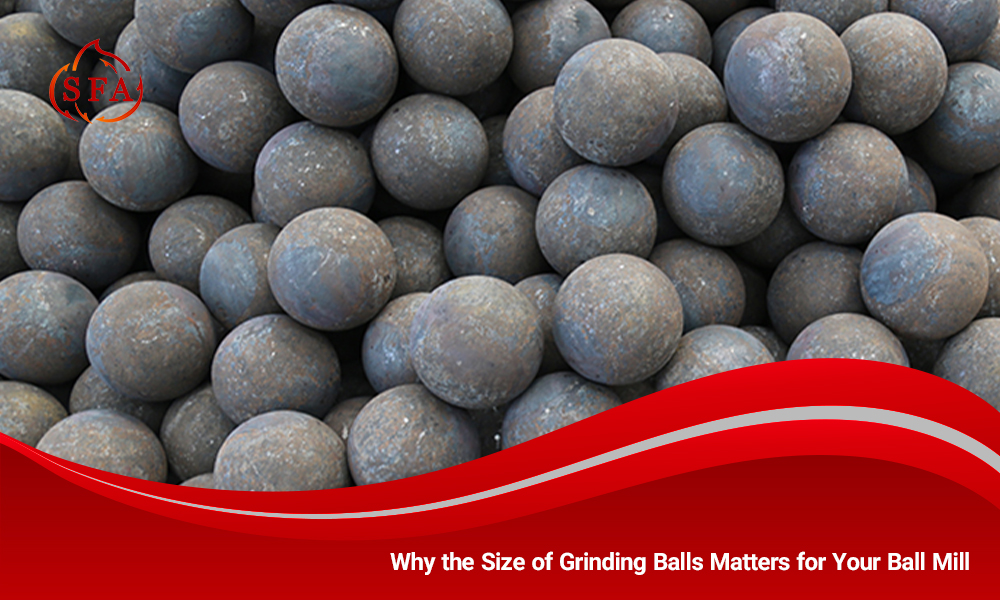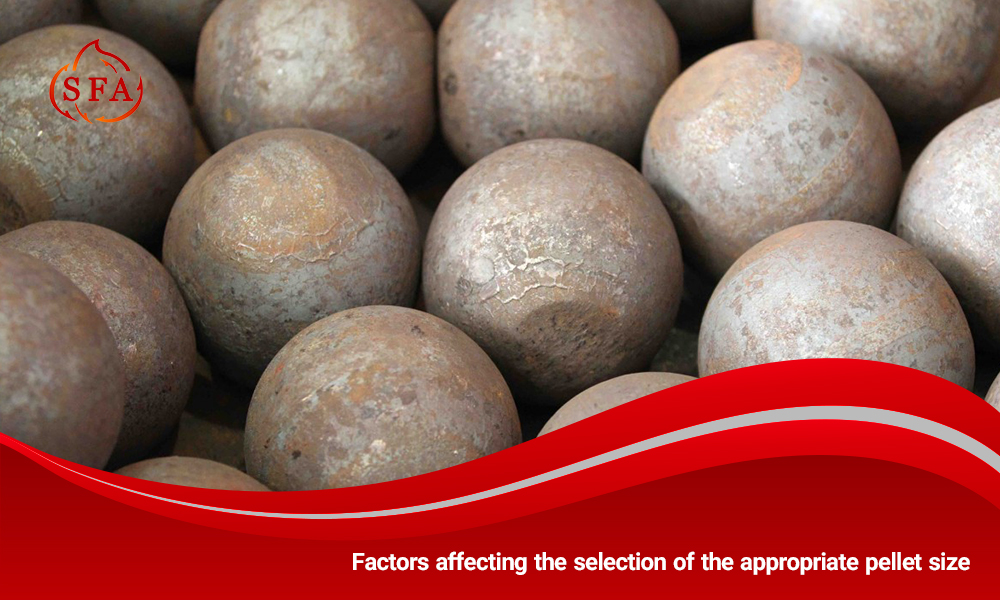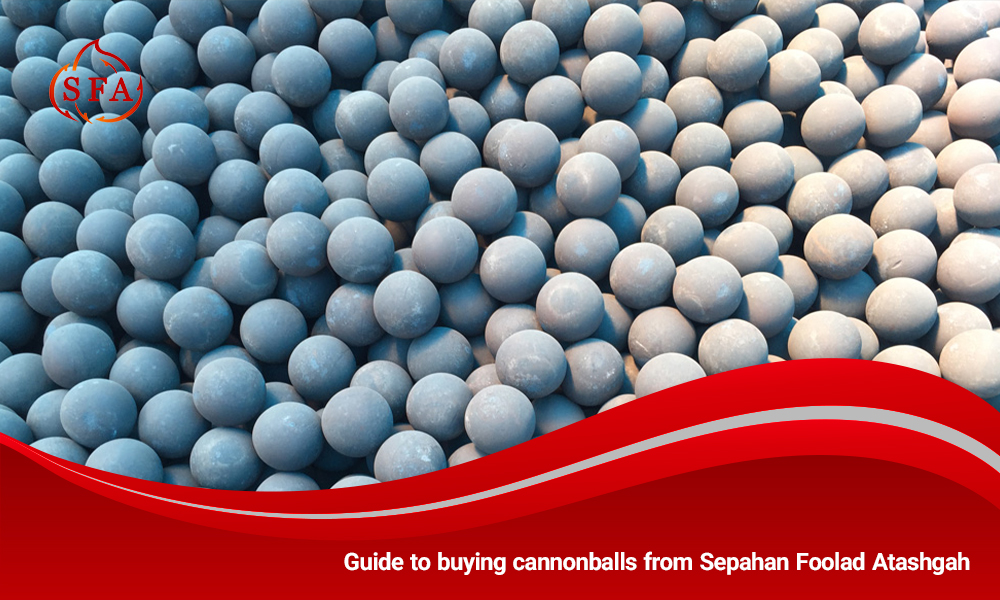

Why the Size of Grinding Balls Matters for Your Ball Mill
Ball mills are essential equipment in mining, cement, ceramic, and steel industries. They are used to grind raw materials efficiently. The size of the grinding balls plays a key role in both design and operation. The English title “Why the Size of Grinding Balls Matters for Your Ball Mill” highlights this importance.
Many engineers and production managers often ask why the ball size must be carefully selected.
Industrial and research sources agree that ball size directly affects mill efficiency, product particle size, and energy use.
This article explores the scientific and technical aspects of the topic. It shows how choosing the right ball size improves grinding quality and reduces operating costs.
In the following article from Sepahan Foolad Atashgah, we will examine this issue in detail.
Effect of pellet size on grinding mechanism
In terms of grinding mechanism, large and small balls each have different functions. Larger balls produce higher impact energy due to their greater weight and can crush coarse particles faster. However, using only large balls reduces the number of impacts and may lower mill capacity.
Large balls grind quickly but can create too many fine particles. This result is often undesirable in certain applications.
In contrast, smaller balls are present in greater numbers in any given volume of mill charge. The high number of surface contacts between the balls and the feed particles results in a finer final product.This is a major advantage for industries that need fine powders or uniform particle sizes, such as minerals, ceramics, and chemicals.
However, small balls have lower impact energy and require longer grinding times to reach fine sizes.
They also wear out faster and may be ejected from the mill, especially in wet conditions or with strong pulses.
In short, the impact energy generation and the number of impacts are two important factors: large pellets have stronger but fewer impacts, and small pellets have weaker but more frequent impacts. For hard materials (high hardness), larger pellets are usually needed to provide sufficient impact force to the particles. Research shows that “smaller pellets generally result in higher milling speeds and finer final particles,” but for hard materials, larger pellets require more impact energy to break up the particles, so the optimal pellet size is usually larger. These findings highlight the importance of choosing a size that is appropriate for the feed properties.
Factors affecting the selection of the appropriate pellet size
The selection of the optimal pellet size for a ball mill depends on a combination of operating parameters and feed material properties. Below we review the most important factors:


Feed particle to pellet size ratio
A common rule of thumb is that the diameter of the pellet should be approximately three times the size of the largest particle of the feed. This ratio ensures that the pellet has enough energy and impact to break up the coarse particles. For example, if the largest grain of the feed material is about 1 mm, it is common to use pellets of about 3 mm.
The degree of fineness of the final product
If the final product needs to be very fine or uniform, it is better to use finer pellets. Smaller pellets provide a more even distribution of impacts and a more uniform grinding. The point is that higher fineness usually costs more in milling time, as the energy per impact is less and the material must remain in the mill longer.
Hardness and type of material
Hard materials, such as iron ore, copper or hard ceramics, require more impact energy to break down. In these cases, “the hardness of the material makes the optimal ball size larger. For example, operators use large balls (about 30–50 mm) to grind iron ore or copper in a furnace, providing strong impacts and sufficient power.
Softer materials, such as quartz or lime, can be ground with medium balls (20–30 mm) to balance grinding speed and product fineness.
Bullet size distribution
A combination of different ball sizes is usually used. Using just one size does not grind all the particles at the same time, especially if the feed has a large range of sizes. Industry studies show that “ball size distribution is very important because it affects grinding speed, product fineness and energy efficiency. A combination of small and large balls can provide the desired performance. Therefore, in many plants, a mixture of coarse balls is used for initial grinding and fine balls are used to achieve the desired final size.
Grinder speed and settings
The speed of the mill and its filling ratio (loading) are also important. In general, increasing the mill speed will result in a somewhat finer final product, as the number of impacts per unit time increases. However, increasing the speed too much can lead to the formation of air bubbles (cataracts) and reduced effective contact. If operators design the mill for a high critical speed, they may use larger balls to avoid runaway effects.
They must also control the volumetric dispersion of the balls in the mill (e.g., 35–50% of the mill volume) to ensure enough space for impact and rotation.
Operators often need to adjust speed and loading parameters along with the choice of ball size.
Wear and tear and cost
The size of the pellets also affects wear and maintenance costs. The smallest pellets have a larger contact surface with the mill wall and therefore wear out more quickly. In contrast, larger pellets provide more useful energy relative to their weight but are more expensive to supply and replace. The classic theory of Bond (1958) emphasizes that “the appropriate pellet size is that which will crush the largest particles of feed; if the pellets are too large, the number of crushing contacts will be reduced and the mill capacity will be reduced.
Optimization of bullet size distribution and field tests
Studies and practical experience show that a diverse size distribution often yields better results. For example, a laboratory study on wet milling of ceramics showed an optimal ball size for each rotational speed.
At 50 rpm, 5 mm balls produced the best result with an average particle size of 2.3 μm.
At 100 rpm, 3 mm balls performed best, achieving an average particle size of 1.4 μm.
This example shows that even in laboratory conditions, there is an optimal ball size for each milling speed.
The optimal size also changes as the speed changes.
In industry, experts recommend adjusting ball composition—both size and material—through field tests and quality control.
For instance, cement producers and mining companies have achieved energy savings or higher capacity by replacing single-size balls with mixed sizes.
Reports also show that adding smaller balls can reduce energy use. Their finer impact energy lowers thermal decomposition and improves efficiency.
The effect of pellet size on energy consumption and efficiency
The selection of ball size is related to the optimization of energy transfer in the mill. Since the grinding process always wastes part of the input energy as heat, any optimization leads to significant savings in operating costs. Mining studies show that grinding processes—including the mills—consume about 50-60% of total energy.
Selecting the right balls reduces this energy consumption.
Optimal balls provide maximum effective force for grinding while minimizing vibration and wasted energy.
Research shows that the main goal of ball selection is to “achieve the desired particle size with the lowest energy consumption and the longest mill life”.For example, an industry article recommends that operators match the ball size to the desired product fineness and material type.
Doing so reduces energy consumption and increases the lifespan of the mill’s internal linings (liners).
Also, as mentioned, using a diverse pellet distribution helps to distribute the input energy more effectively across the particle spectrum; this can lead to reduced overload and energy fluctuations. In summary, depending on the operating conditions, a smart pellet size strategy can reduce the mill’s specific energy consumption (kWh/tonne of material) and increase the overall mill efficiency. In this way, proper pellet preparation and maintenance can reduce depreciation and energy costs and increase profitability.
Tips and common mistakes in choosing bullet size
Incorrect selection of pellet size can lead to poor mill efficiency. Some common mistakes include:
Using only one bullet size
It is sometimes mistakenly used to simplify the process by using only one size of ball in the mill. This often limits the efficiency and may necessitate the need for a two-stage mill. It is advisable to always have several different sizes ready for testing.
Ignoring the wear rate
Over time, the pellets wear out and their diameter decreases. If care is not taken and new pellets are not added in a timely manner, the size distribution becomes unfavorable and efficiency decreases.
Overloading or underloading
A substandard amount of pellets in the mill (e.g., more than 50% of the mill volume or much less) can lead to improper impact settings, high energy consumption, and reduced capacity.
No change in size with change in feed
If the type or granulation of the input material changes (e.g., hardness or particle size increases), operators should review the pellet size. Continuing to operate with the old settings against the new feed can reduce efficiency.


Guide to buying cannonballs from Sepahan Foolad Atashgah
Sepahan Foolad Atashgah Company is one of the leading manufacturers of castings and steel mill balls in the country.
With years of experience and modern technical expertise, the company produces durable, high-quality products using premium raw materials.
It designs and manufactures mill balls with standard hardness, abrasion resistance, and dimensional uniformity for the cement, steel, ceramic, and mining industries.
If you are looking to increase mill efficiency, reduce energy consumption, and improve the quality of the final product, choosing Sepahan Foolad Atashgah standard pellets will be the best option. The company’s technical experts and CEO are ready to review the conditions of your production line and recommend the most appropriate size and composition of pellets. By purchasing directly from Sepahan Foolad Atashgah, in addition to quality assurance and competitive prices, you will also benefit from specialized support and consulting services.
Conclusion
As a result, the answer to the question “Why the Size of Grinding Balls Matters for Your Ball Mill” is clear: the size and distribution of the balls directly affect the efficiency of the mill, the quality of the final product and the energy costs. Larger balls provide a strong impact force and a high volume of energy, while smaller balls provide a larger contact surface and are suitable for achieving finer particles.
Operators usually use a suitable combination of large and medium balls—and, in special cases, an intermediate size—to grind a wide range of particles.
They should choose ball size based on feed size and hardness, grinding speed, abrasive material, and practical test results.
By following these principles and applying insights from scientific and commercial sources (such as the rule of three and operational studies), operators can increase mill efficiency and productivity.


